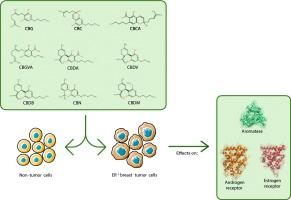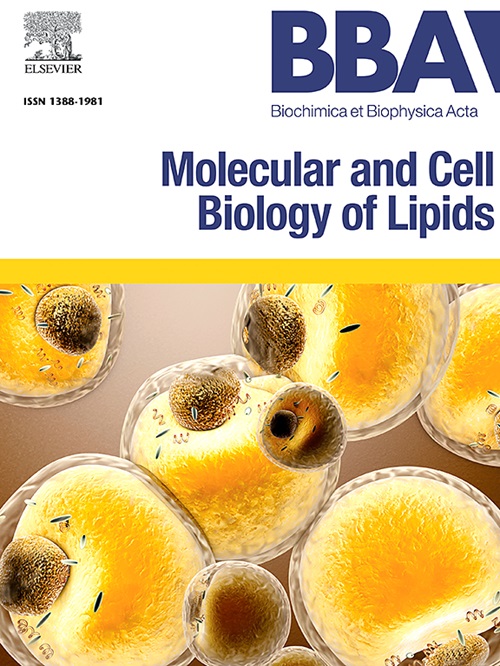Impact of minor cannabinoids on key pharmacological targets of estrogen receptor-positive breast cancer
IF 3.3
2区 生物学
Q2 BIOCHEMISTRY & MOLECULAR BIOLOGY
Biochimica et biophysica acta. Molecular and cell biology of lipids
Pub Date : 2025-07-02
DOI:10.1016/j.bbalip.2025.159658
引用次数: 0
Abstract
Endocrine therapy for estrogen receptor-positive (ER+) breast cancer has significantly improved over the last decades. However, it presents some limitations that make the search for novel therapeutic options mandatory. Several studies have been conducted to understand the anti-tumor potential of cannabinoids in breast cancer. Yet, most of them are focused on the major phytocannabinoids Δ9-tetrahydrocannabinol (THC) and cannabidiol (CBD). However, Cannabis has other minor phytocannabinoids whose anti-cancer properties are still to be elucidated. Here, we investigated the mechanisms of action of four minor cannabinoids, cannabigerol (CBG), cannabidivarin (CBDV), cannabinol (CBN), and cannabichromene (CBC), in 2D and 3D ER+ breast cancer models. These cannabinoids dysregulate MCF-7aro cell cycle progression, induce apoptosis by different mechanisms, and inhibit the growth of MCF-7aro spheroids. CBG exerts its effects through a down-regulation of both ER and AR protein levels, while CBDV reduces aromatase protein levels. CBN and CBC simultaneously affect the three targets, ER, aromatase, and AR. In fact, CBN and CBC present an AR-dependent cell death, down-regulate aromatase levels, and act as ER negative regulators impairing cancer cell growth. CBN caused the most pronounced effects. Overall, this study highlights the anti-cancer properties and the therapeutic potential of these minor cannabinoids in ER+ breast cancer.

少量大麻素对雌激素受体阳性乳腺癌关键药理靶点的影响。
雌激素受体阳性(ER+)乳腺癌的内分泌治疗在过去几十年中有了显着改善。然而,它提出了一些限制,使得寻找新的治疗方案势在必行。已经进行了几项研究来了解大麻素在乳腺癌中的抗肿瘤潜力。然而,大多数研究都集中在主要的植物大麻素Δ9-tetrahydrocannabinol (THC)和大麻二酚(CBD)上。然而,大麻还有其他少量的植物大麻素,其抗癌特性仍有待阐明。在这里,我们研究了四种次要大麻素,大麻酚(CBG),大麻二酚(CBDV),大麻酚(CBN)和大麻色素(CBC)在2D和3D ER+乳腺癌模型中的作用机制。这些大麻素通过不同机制调节MCF-7aro细胞周期进程,诱导细胞凋亡,抑制MCF-7aro球体的生长。CBG通过下调ER和AR蛋白水平发挥作用,而CBDV通过降低芳香化酶蛋白水平发挥作用。CBN和CBC同时影响ER、芳香化酶和AR这三个靶标。事实上,CBN和CBC表现出AR依赖性的细胞死亡,下调芳香化酶水平,并作为ER负调节因子损害癌细胞生长。CBN造成了最明显的影响。总的来说,这项研究强调了这些小大麻素在ER+乳腺癌中的抗癌特性和治疗潜力。
本文章由计算机程序翻译,如有差异,请以英文原文为准。
求助全文
约1分钟内获得全文
求助全文
来源期刊
CiteScore
11.00
自引率
2.10%
发文量
109
审稿时长
53 days
期刊介绍:
BBA Molecular and Cell Biology of Lipids publishes papers on original research dealing with novel aspects of molecular genetics related to the lipidome, the biosynthesis of lipids, the role of lipids in cells and whole organisms, the regulation of lipid metabolism and function, and lipidomics in all organisms. Manuscripts should significantly advance the understanding of the molecular mechanisms underlying biological processes in which lipids are involved. Papers detailing novel methodology must report significant biochemical, molecular, or functional insight in the area of lipids.

 求助内容:
求助内容: 应助结果提醒方式:
应助结果提醒方式:


